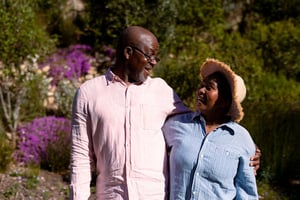4 min read Best Hearing Aids for Your Level of Hearing Loss Different levels of hearing loss can...
The Role of Exercise and Physical Activity in Maintaining Auditory Health: Insights for the 45-70 Age Group
4 min read
The intricate relationship between exercise, physical activity, and auditory health is a subject of utmost importance. Sure, the benefits of exercise for our overall well-being are well-known. Remarkably, our level of fitness can significantly impact our auditory function and the onset of potential hearing loss. In this article, we will delve into the complex role of exercise and physical activity in maintaining auditory health. Furthermore, we shall explain the implications of hearing loss on our ability to perceive certain sounds as we age. Lastly, we will provide a comprehensive overview of the normal hearing ranges, empowering individuals to recognize potential signs of age-related hearing loss more discerningly.
Hearing loss bears the potential to be profoundly life-altering, rendering individuals susceptible to a plethora of practical and emotional challenges. Safeguarding our hearing abilities for as long as possible is of vital importance. Although hearing aids and assistive technologies exist to mitigate the impact of hearing loss, it is preferable to proactively minimize the risk of hearing damage and the subsequent onset of hearing loss. This necessitates learning about the nature of hearing loss, familiarizing oneself with its telltale signs, and adopting preventive measures to protect our auditory faculties. As a preliminary step, let’s explore the role of exercise and physical activity in maintaining auditory health.

Level of Fitness and Hearing
There is a distinct connection between level of fitness and hearing. Engaging in cardiovascular exercises, for instance, yields benefits in preserving one's hearing ability. Exercise exhibits the capacity to mitigate inflammation and enhance blood flow, essential factors that safeguard the delicate auditory system. Consequently, regular physical activity not only maintains overall physical well-being but also contributes to the protection against hearing loss. Nonetheless, as we age, it becomes imperative to consult regularly with healthcare professionals to ensure that exercise regimens remain safe and suitable. Medical experts can provide tailored recommendations to accommodate any specific movement limitations while simultaneously protecting against hearing loss. This is particularly crucial within the 45-70 age bracket.
It is equally important to develop an awareness of the defining characteristics of hearing loss and the parameters of a normal hearing range. Preparing ourselves with this knowledge enables us to promptly recognize potential signs of hearing loss, fostering proactive intervention and management. Regular auditory evaluations serve as indispensable tools for monitoring any changes in hearing acuity that may transpire. Given the inherent limitations in naturally regaining lost hearing function, a proactive stance is best.
By acknowledging the role of exercise and physical activity in maintaining auditory health, we unlock a pathway toward preserving our auditory faculties. Regular consultations with healthcare professionals, coupled with periodic auditory evaluations, empower us to proactively address any potential hearing challenges. Through this proactive approach, we pave the way for a life marked by optimal auditory well-being and enhanced quality of life.
60-Decibel Hearing Loss
It is important to not only evaluate the impact of sound intensity but also to discern any signs of difficulty in perceiving various sound levels. Understanding the relative loudness of typical sounds serves as a vital reference point. For instance, a whispered conversation registers at approximately 40 decibels (dB), whereas industrial noise reaches around 100 dB, and thunder striking nearby can peak at 120 dB. It is worth noting that each increment of 10 dB is subjectively perceived as being twice as loud.
In terms of hearing loss categorizations, mild hearing loss falls within the range of 20 to 40 dB, while moderate hearing loss spans from 41 to 60 dB. It is important to highlight that any hearing loss exceeding 40 dB is deemed as a hearing impairment, with a 60-decibel hearing loss specifically falling into this category. OTC hearing aids are made specifically to aid those with hearing loss that falls into these categories.
Now that we have established the implications of a 60-decibel hearing loss, it is essential to explore the parameters of normal hearing range for individuals in their sixties. As part of the natural aging process, it is imperative to undergo regular hearing assessments to promptly identify any potential hearing deficiencies that may necessitate the use of hearing aids. Such proactive monitoring of auditory health can significantly enhance overall well-being and improve health outcomes.

What’s the Normal Hearing Range for 60-Year-Olds
Presbycusis, the age-related decline in hearing, is a prevalent condition among the elderly population, with one-third of individuals over the age of 65 experiencing hearing loss. However, understanding the normal hearing range for 60-year-olds becomes crucial as we delve into middle age and beyond.
As we enter middle age and progress through the later stages of life, it is prudent to recognize signs of age-related hearing loss. These indicators may manifest as difficulties in hearing conversations or comprehending television audio. The aging process affects both the structures within the ear and the auditory processing pathways in the brain, contributing to the gradual onset of hearing loss. Additionally, genetics can influence the onset and severity of age-related hearing loss. While minimizing avoidable factors like exposure to loud music, environmental noise, and occupational hazards can be beneficial for preserving hearing health, it is equally important to be cognizant of the normal hearing range for individuals in their sixties and beyond, taking into account one's own age-related changes.
The normal hearing range for 60-year-olds aligns with that of healthy adults. Generally, adults possess the ability to hear sounds within the frequency range of 20 to 20,000 Hertz (Hz). The higher the Hz value (frequency), the higher-pitched the sound. However, as individuals age, their capacity to hear higher-frequency sounds gradually diminishes. For instance, individuals under 30 years of age typically have the ability to detect sounds at 16,000 Hz, while those under 50 years of age should be capable of perceiving sounds at 12,000 Hz. However, individuals over 60 years of age may struggle to hear sounds above 12,000 Hz. Undergoing an auditory test can assist in determining the presence of hearing loss and the potential need for hearing aids. It is worth noting that the role of exercise and physical activity in maintaining auditory health should be considered as part of an integrated approach to hearing care.

Hearing Better With Soundwave
At Soundwave, we want you to find the right hearing solution that can work for you. Our Sontro® OTC Hearing Aids work in tandem with our otoTune® app, which provides you with a 3 min hearing test that actually programs your hearing aids to your specific hearing loss. So, trust in our user-friendly system and buy Soundwave’s hearing aids today.



